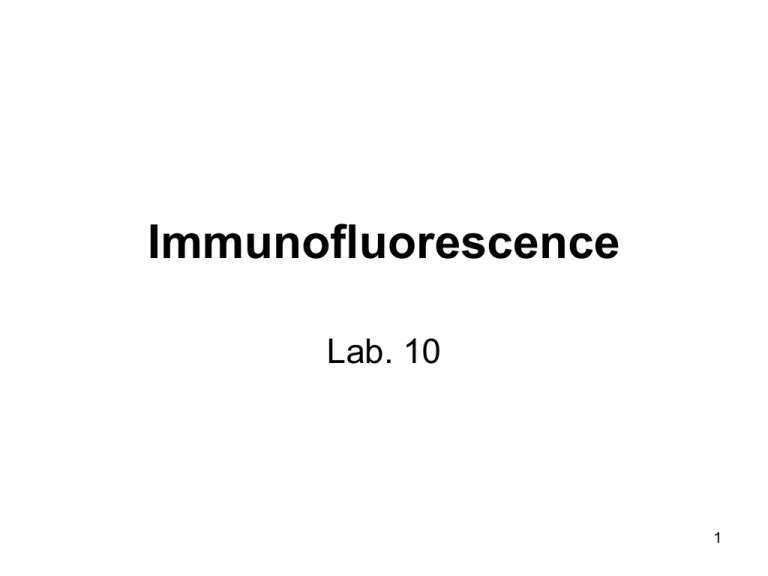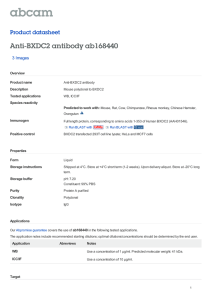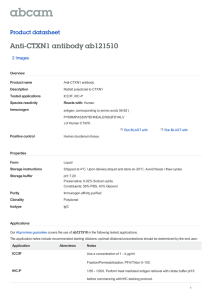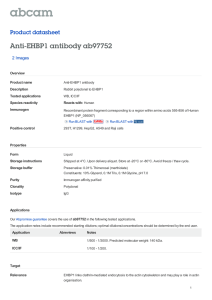Immunofluorescence
advertisement

Immunofluorescence Lab. 10 1 Immunofluorescence • If antibody molecules are tagged with a fluorescent dye, immune complexes containing these fluorescently labeled antibodies (FA) can be detected by colored light emission when excited by light of the appropriate wavelength. • Antibody molecules bound to antigens in cells or tissue sections can similarly be visualized. • The emitted light can be viewed with a fluorescence microscope, which is equipped with an UV light source. • In this technique, known as immunofluorescence, fluorescent compounds such as: fluorescein rhodamine, and phycoerythrin, • are coupled to Abs which then ca be detected by fluorescence microscope 2 • positive test • negative test 3 Immunofluorescence • Fluorescent-antibody can be used for staining of cell membrane molecules or tissue sections • In this way, the distribution of antigen throughout a tissue and within cells can be demonstrated. • The method can also be used for the detection of antibodies directed against antigens already known to be present in a given tissue section or cell preparation. • There are two types of IF: • Direct • Indirect 4 Direct immunofluorescence • The antibody to the tissue antigen is conjugated with the fluorochrome and applied directly. • For example, to show the distribution of a thyroid autoantigen reacting with the autoantibodies present in the serum of a patient with Hashimoto's disease, a type of thyroid autoimmunity. • Isolate IgG from the patient's serum, conjugate it with fluorescein, and apply it to a section of human thyroid on a slide. • When viewed in the fluorescence microscope, the cytoplasm of the follicular epithelial cells will be brightly stained. 5 Direct Immunofluorescence • Ab to tissue Ag is labeled with fluorochrome Fluorochrome Labeled Ab Ag Tissue Section 6 Indirect immunofluorescence • In this double-layer technique, – the unlabeled antibody is applied directly to the tissue substrate – and visualized by treatment with a fluorochromeconjugated anti-immunoglobulin serum • A number of reagents have been developed for indirect staining. • The most common is a fluorochrome-labeled secondary antibody raised in one species against antibodies of another species. 7 Indirect immunofluorescence • In this case, in order to find out whether or not the serum of a patient has antibodies to thyroid epithelial cells, • First treat a thyroid section with the serum, • wash well and then apply a fluoresceinlabeled rabbit anti-human immunoglobulin; • If antibodies were present, there would be staining of the thyroid epithelial cells. 8 Indirect Immunofluorescence • Ab to tissue Ag is unlabeled • Fluorochrome-labeled anti-Ig is used to detect binding of the first Ab. Fluorochrome Labeled Anti-Ig Unlabeled Ab Ag Tissue Section 9 10 Advantages of Indirect IF • In the first place the fluorescence is brighter than with the direct test since several fluorescent antiimmunoglobulins bind on to each of the antibody molecules present in the first layer. • Second, even when many sera have to be screened for specific antibodies it is only necessary to purchase a single labeled reagent. • The primary antibody does not need to be conjugated with a fluorochrome. Because the supply of primary antibody is often a limiting factor, indirect methods avoid the loss of antibody that usually occurs during the conjugation reaction. • One can also test for complement fixation on the tissue section by adding a mixture of the first antibody plus a source of complement, followed by a fluorescent 11 anticomplement reagent as the second layer. Immunofluorescence Direct Indirect • Fix specimen on slide • Fix specimen on slide • Add antibody specific • Add antibody specific for the desired antigen • Look for fluorescence for the desired antigen • Add second antibody • Look for fluorescence 12 Applications: Immunofluorescence • Immunofluorescence has been applied to identify a number of subpopulations of lymphocytes, – notably the CD4+ and CD8+ T-cell subpopulations. – The technique is also suitable for identifying bacterial species, – detecting Ag-Ab complexes in autoimmune disease, – detecting complement components in tissues, – and localizing hormones and other cellular products stained in situ. • A major application of the fluorescent-antibody technique is the localization of antigens in tissue sections or in subcellular compartments. 13 Detection of Autoantibodies • Autoimmune diseases are characterized by antibodies directed against self antigens. • These autoantibodies can be detected on human or animal tissue or cells. • Immunofluorescence is considered as the standard test for screening and confirmation of autoantibodies. 14 Controls • Reagent and tissue controls are necessary for the validation of immunofluorescence staining results. • Without their use, interpretation of staining would be haphazard and the results of doubtful value. • More specifically, controls determine if the staining protocols were: – – – – followed correctly, whether day-to-day and worker-to-worker variations have occurred, and that reagents remain in good working order. 15 Controls • In carrying out an immunofluorescence experiment one has to be confident that the reaction is specific and that the Ab is in fact binding selectively to the target Ag and not to other components of the cell or other closely related Ags. • In addition if no fluorescence is observed with the probe does this mean that the Ag is not present or it mean that there may be a problem with preparation or with the tissue itself? • If the correct controls are included in the experiment we can, with high certainty, answer these questions 16 Positive and Negative Controls • TISSUE CONTROLS can be of either negative or positive. • NEGATIVE TISSUE CONTROLS Specimens serving as negative controls must be processed (fixed, embedded) identically to the unknown, but do not contain the target antigen. – If you detect a signal then this suggests the problem exists within your technique or protocol • POSITIVE TISSUE CONTROLS Again, these controls must be processed identically to the specimen but contain the target antigen. • If you detect no signal then this suggests the problem exists within your technique or protocol. 17 Antinuclear Antibodies (ANA) How is it used? • The ANA test is ordered to help screen for autoimmune disorders and is most often used as one of the tests to diagnose systemic lupus erythematosus (SLE). • Depending on the patient’s symptoms and the suspected diagnosis, ANA may be ordered along with one or more other autoantibody tests. • Other laboratory tests associated with presence of inflammation, such as • erythrocyte sedimentation rate (ESR) • and/or C-reactive protein (CRP) may also be ordered. 18 When is it ordered? • The ANA test is ordered when a patient shows signs and symptoms that are associated with SLE or another autoimmune disorder. • Patients with autoimmune disorders can have a wide variety of symptoms such as low-grade fever, joint pain, fatigue, and/or unexplained rashes that may change over time. 19 What does the test result mean? • ANA tests are performed using different assays (indirect immunofluorescence microscopy or by ELISA). • Results are reported as a titer with a particular type of immunofluroscence pattern (when positive). • Low-level titers are considered negative, while increased titers are positive • ANA shows up on indirect immunofluorescence as fluorescent patterns in cells that are fixed to a slide that is evaluated under a microscope. 20 • Different patterns are associated with a variety of autoimmune disorders. • Some of the more common patterns include: • Homogenous (diffuse) - associated with SLE and mixed connective tissue disease • Speckled - associated with SLE, Sjogren’s syndrome, scleroderma, polymyositis, rheumatoid arthritis, and mixed connective tissue disease • Nucleolar - associated with scleroderma and polymyositis • Outline pattern (peripheral) -associated with SLE 21 Patterns of ANA diffuse staining Peripheral pattern speckled pattern nucleolar pattern 22 Flow Cytometer • The fluorescent antibody techniques described are extremely valuable qualitative tools, • but they do not give quantitative data. • This shortcoming was remedied by development of the flow cytometer, which was designed to automate the analysis and separation of cells stained with fluorescent antibody. 23 Flow Cytometer • Flow cytometry uses the principles of – light scattering , – light excitation, – and emission of fluorochrome molecules • to generate specific multi-parameter data from particles and cells in the size range of 0.5 µm to 40 µm diameter. • Cells are hydro-dynamically focused in a sheath of PBS before intercepting an optimally focused light source. • Lasers are most often used as a light source in flow cytometry. 24 Flow Cytometer • More sophisticated versions of the instrument are capable of sorting populations of cells into different containers according to their fluorescence profile. • Flow cytometry also makes it possible to analyze cell populations that have been labeled with two or even three different fluorescent antibodies. • For example, if a blood sample is reacted with a fluorescein-tagged antibody specific for T cells, and also with a phycoerythrin-tagged antibody specific for B cells, the percentages of B and T cells may be determined simultaneously with a single analysis. • highly sophisticated versions of the flow cytometer can even perform “five-color” analyses 25 Applications: Flow Cytometry • Characterization of cell size, complexity, antigens • Examples: • diagnosis of leukemia and lymphoma • determination of CD4/CD8 counts in patients with HIV 26 WBCs analysis • A common clinical use is to determine the kind and number of white blood cells in blood samples. • By treating appropriately processed blood samples with a fluorescently labeled antibody and performing flow cytometric analysis, one can obtain the following information: 27 WBCs analysis 1. How many cells express the target antigen as an absolute number and also as a percentage of cells passing the beam. – For example, if one uses a fluorescent antibody specific for an antigen present on all T cells, it would be possible to determine the percentage of T cells in the total white blood cell population. – Then, using the cell-sorting capabilities of the flow cytometer, it would be possible to isolate the T-cell fraction of the leukocyte population. 28 WBCs analysis 2. The distribution of cells in a sample population according to antigen densities as determined by fluorescence intensity. – It is thus possible to obtain a measure of the distribution of antigen density within the population of cells that possess the antigen. – This is a powerful feature of the instrument, since the same type of cell may express different levels of antigen depending upon its developmental or physiological state. 3. The size of cells. – This information is derived from analysis of the light-scattering properties of members of the cell population under examination. 29 labeled with fluorescein (green) labeled with rhodamine (red) (exciting the fluorochrome) ↓ each droplet (cell) emits the fluorescence (small electrical change) each dot represents a cell Separation of fluorochrome-labeled cells with the flow cytometer which uses a laser beam & light detector. 30 : different Ag in different cells / different levels of Ag in the same type of cell → fluorescence intensity / the size of cells. SAMPLE SHEATH LASER 31 32 Immunofluorescence • Flow Cytometry Cells in suspension are labeld with fluorescent tag Cells analyzed on a flow cytometer Flow Tip FL Detector Light Scatter Detector Laser 33






